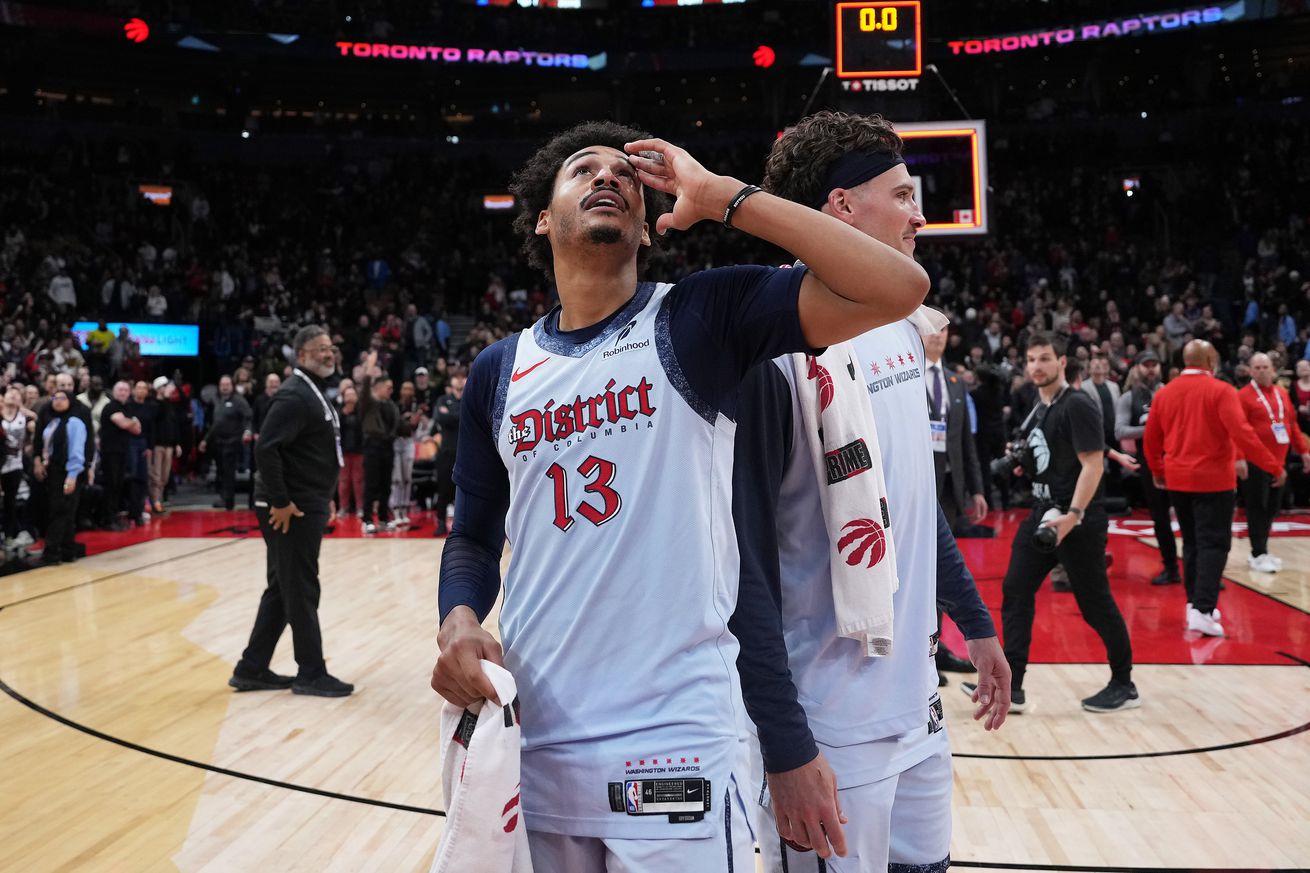
Recap, stats, analysis, commentary
The Washington Wizards tipped off their seven-game road trip with a 118-117 win over the Toronto Raptors. The two teams face each other again Monday night in Toronto.
The Wizards trailed by six at the end of the first quarter as both teams let the opponent offense run wild. The offensive onslaught continued for Washington in the second period — the Wizards outscored the Raptors by 10 to enter halftime up four.
The second half saw either an increase in defensive effectiveness or a decrease in offensive effectiveness, depending on your perspective. There wasn’t much visible to the eye (especially on my glitchy feed) to suggest either team played better on the defensive end, but the results improved for both.
The Wizards led by as much as 13 in the third quarter, though Toronto came back each time and sliced the advantage to as little as two in the fourth quarter. During the final period, Raptors head coach Darko Rajaković made what felt like a tank move — benching his starters and going with a bench mob. The bench mob came back, reduced Washington’s lead to a single point, and set up a nutty finish.
That nutty finish included an inbounds play with 2.3 seconds remaining and the Wizards up one. Raptors rookie guard Jamal Shead was having trouble finding a teammate for the inbounds pass, and he appeared to step on the boundary line. Which would have been a turnover if the refs had noticed. Instead, they granted Toronto a timeout.
Rajaković used the timeout to call a different inbounds play, and it was a good one. Shead received the pass out top and immediately drove past Wizards guard Marcus Smart. Shead laid the ball up and it went it went in with the final buzzer sounding — an apparent win for Raptors.
Except…the refs reviewed the play and decided he hadn’t gotten the shot out of his hand before time expired. I’m not sure how they made that determination — at least based on the replays shown on the TV broadcast — but the Wizards escaped with a win.
The Recitation of Woes
For a second straight game, the Wizards faced an opponent with an injury-riddled roster. Toronto was missing:
- Brandon Ingram — ankle
- Immanuel Quickley — rest
- Gradey Dick — knee
- Ochai Agbaji — ankle
- Chris Boucher — mouth
- Jonathan Mogbo — face
- Ulrich Chomche — knee
- Ja’Kobe Walter — quadriceps
Washington saw the return of Jordan Poole and Richaun Holmes to the lineup. They had Malcolm Brogdon (ankle), Saddiq Bey (knee), and Colby Jones (Achilles) sidelined with injuries.
Bright Spots for the Wizards
- Jordan Poole was super productive in his first action since missing three games with a hyperextended right elbow. He scored 34 points on 20 shots, including hitting 7-12 from three-point range.
- Bilal Coulibaly was aggressive (24.0% usage) and reasonably efficient (115 offensive rating) and he notched 10 rebounds, 4 assists, and 4 steals.
- Richaun Holmes had 10 points and 11 rebounds in just 20 minutes.
- Khris Middleton had another savvy veteran kind of game — just solid all-around play and good decision-making that helped put teammates
- Alex Sarr shot poorly but tied his career high of 14 rebounds.
Four Factors
Below are the four factors that decide wins and losses in basketball — shooting (efg), rebounding (offensive rebounds), ball handling (turnovers), fouling (free throws made).
The four factors are measured by:
- eFG% (effective field goal percentage, which accounts for the three-point shot)
- OREB% (offensive rebound percentage)
- TOV% (turnover percentage — turnovers divided by possessions)
- FTM/FGA (free throws made divided by field goal attempts)
In the table below are the four factors using the percentages and rates traditionally presented. There’s also a column showing league average in each of the categories to give a sense of each team’s performance relative to the rest of the league this season.
Stats & Metrics
Below are a few performance metrics. PPA is my overall production metric, which credits players for things they do that help a team win (scoring, rebounding, playmaking, defending) and dings them for things that hurt (missed shots, turnovers, bad defense, fouls).
PPA is a per possession metric designed for larger data sets. In small sample sizes, the numbers can get weird. In PPA, 100 is average, higher is better and replacement level is 45. For a single game, replacement level isn’t much use, and I reiterate the caution about small samples sometimes producing weird results.
POSS is the number of possessions each player was on the floor in this game.
ORTG = offensive rating, which is points produced per individual possessions x 100. League average last season was 114.8. Points produced is not the same as points scored. It includes the value of assists and offensive rebounds, as well as sharing credit when receiving an assist.
USG = offensive usage rate. Average is 20%.
ORTG and USG are versions of stats created by former Wizards assistant coach Dean Oliver and modified by me. ORTG is an efficiency measure that accounts for the value of shooting, offensive rebounds, assists and turnovers. USG includes shooting from the floor and free throw line, offensive rebounds, assists and turnovers.
+PTS = “Plus Points” is a measure of the points gained or lost by each player based on their efficiency in this game compared to league average efficiency on the same number of possessions. A player with an offensive rating (points produced per possession x 100) of 100 who uses 20 possessions would produce 20 points. If the league average efficiency is 114, the league — on average — would produced 22.8 points in the same 20 possessions. So, the player in this hypothetical would have a +PTS score of -2.8.
Players are sorted by total production in the game.
